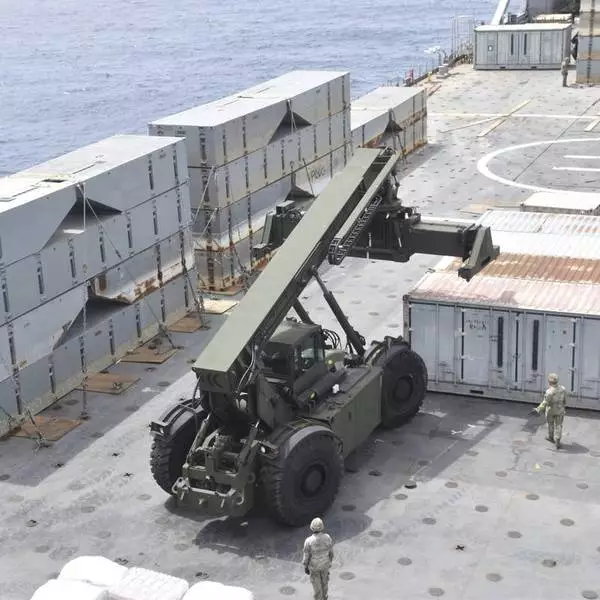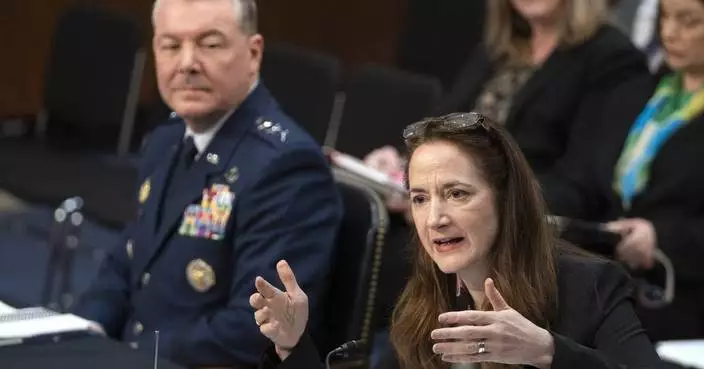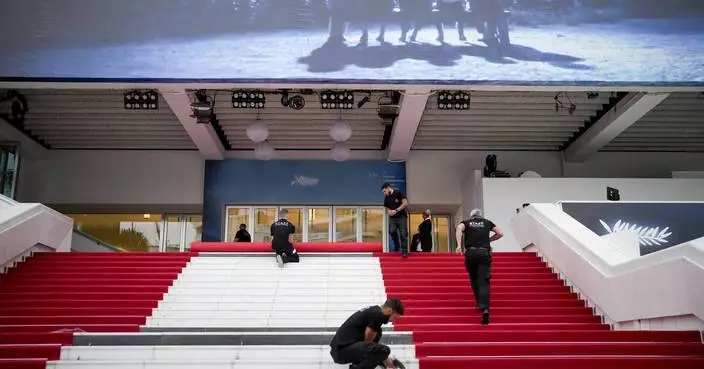For only the fourth time in U.S. history, the House of Representatives has started a presidential impeachment inquiry. House committees are trying to determine whether President Donald Trump violated his oath of office by asking Ukraine to investigate political rival Joe Biden and his family and to investigate the country's involvement in the 2016 U.S. presidential election.
A quick summary of the latest news and what's to come:
WHAT YOU NEED TO KNOW

Demonstrators march on Pennsylvania Avenue protesting against climate policies and to impeach President Donald Trump, in Washington, Friday, Nov. 8, 2019. (AP PhotoJose Luis Magana)
— Investigators in the inquiry on Friday released hundreds of pages of testimony from Fiona Hill, a former White House Russia adviser, and Lt. Col. Alexander Vindman, an Army officer assigned to the National Security Council. Both testified they were concerned Trump was inappropriately pressuring Ukraine to investigate Democrats.
— Ivanka Trump told The Associated Press Friday that the identity of whistleblower is "not particularly relevant" and "shouldn't be a substantive part of the conversation." The whistleblower sparked the inquiry into Trump's efforts to pressure Ukraine to investigate former vice president Joe Biden and his son Hunter Biden.
— John Bolton, Trump's former national security adviser, was aware of "many relevant meetings and conversations" related to the Ukraine pressure campaign that House impeachment investigators have not yet learned about, his attorney Charles Cooper wrote in a letter to the House general counsel. Cooper wants a federal judge to determine whether Bolton and his former deputy, Charles Kupperman, can be compelled to testify against the White House wishes.
— Acting White House chief of staff Mick Mulvaney and Office of Management and Budget associate director Marky Sandy defied House investigator subpoenas and were no-shows for their scheduled depositions. Mulvaney has asked to join a lawsuit brought by another of the president's advisers challenging a congressional subpoena. That suit, filed by former deputy national security adviser Charles Kupperman, asks a court to decide which of two directives Kupperman must follow — one from Congress ordering him to testify, the other from the White House telling him not to. A lawyer for Mulvaney says his case presents the same legal issues as Kupperman's and that he is a closer and even more senior adviser to the president than Kupperman was.
WHAT'S NEXT
Investigators are preparing to start public hearings next week. House Intelligence Committee Chairman Adam Schiff said three State Department witnesses will appear in two hearings next Wednesday and Friday: U.S. ambassador to Ukraine Bill Taylor, career department official George Kent and Marie Yovanovitch, the former U.S. ambassador to Ukraine. Yovanovitch was ousted in May on Trump's orders and Taylor replaced her; both have testified about their concerns with the administration's policy on Ukraine.
NUMBERS THAT MATTER
This week, a dozen Trump administration figures, including high-profile names like Mulvaney and Bolton, declined to appear before the Democratic-led panel. Democrats are wrapping up the closed-door portion of the proceedings.
WORTH WATCHING
First daughter and presidential aide Ivanka Trump granted a rare interview to The Associated Press while on a trip to Morocco. She questioned the motives of the anonymous whistleblower whose allegations touched off the Trump impeachment inquiry and suggested that former Vice President Joe Biden profited from his time in public service: http://apne.ws/dSkeyf0
WORTH READING
The House committees probing Trump's Ukraine dealings released transcripts of the depositions of Vindman and Hill.
Vindman transcript: http://apne.ws/hOMTyHP
Hill transcript: http://apne.ws/ShWUXZO
Previously released transcripts:
State Department official George Kent: http://apne.ws/gX69QfC
Amb. William Taylor, who is scheduled to testify at an open hearing next Wednesday: http://apne.ws/vtAi9aX
Gordon Sondland, U.S. ambassador to the European Union: http://apne.ws/8NmlA02
Kurt Volker, former U.S. envoy to Ukraine: http://apne.ws/rTdEmG4
Michael McKinley, former adviser to Secretary of State Mike Pompeo: http://apne.ws/PrBMFaM
Marie Yovanovitch, former U.S. ambassador to Ukraine, also scheduled to testify at an open hearing next week: http://apne.ws/mBvxghb
WASHINGTON (AP) — The U.S. military finished installing a floating pier for the Gaza Strip on Thursday, with officials poised to begin ferrying badly needed humanitarian aid into the enclave besieged over seven months of intense fighting in the Israel-Hamas war.
The final, overnight construction sets up a complicated delivery process more than two months after U.S. President Joe Biden ordered it to help Palestinians facing starvation as food and other supplies fail to make it in as Israel recently seized the key Rafah border crossing in its push on that southern city on the Egyptian border.
Fraught with logistical, weather and security challenges, the maritime route is designed to bolster the amount of aid getting into the Gaza Strip, but it is not considered a substitute for far cheaper land-based deliveries that aid agencies say are much more sustainable. The boatloads of aid will be deposited at a port facility built by the Israelis just southwest of Gaza City and then distributed by aid groups.
U.S. troops will not set foot in Gaza, American officials insist, though they acknowledge the danger of operating near the war zone.
Heavy fighting between Israeli troops and Palestinian militants on the outskirts of Rafah has displaced some 600,000 people, a quarter of Gaza’s population, U.N. officials say. Another 100,000 civilians have fled parts of northern Gaza now that the Israeli military has restarted combat operations there.
Pentagon officials said the fighting in Gaza wasn’t threatening the new shoreline aid distribution area, but they have made it clear that security conditions will be monitored closely and could prompt a shutdown of the maritime route, even just temporarily. Already, the site has been targeted by mortar fire during its construction and Hamas has threatened to target any foreign forces who “occupy” the Gaza Strip.
The “protection of U.S. forces participating is a top priority. And as such, in the last several weeks, the United States and Israel have developed an integrated security plan to protect all the personnel who are working," said Navy Vice Adm. Brad Cooper, a deputy commander at the U.S. military's Central Command. "We are confident in the ability of this security arrangement to protect those involved.”
U.S. troops anchored the pier at 7:40 a.m. local time Thursday, the military's Central Command said in a statement, which stressed that none of its forces entered the Gaza Strip.
“Trucks carrying humanitarian assistance are expected to begin moving ashore in the coming days,” the statement said. “The United Nations will receive the aid and coordinate its distribution into Gaza.”
It wasn't immediately clear which U.N. agency would be involved.
Israeli forces will be in charge of security on the shore, but there are also two U.S. Navy warships near the area in the eastern Mediterranean Sea, the USS Arleigh Burke and the USS Paul Ignatius. Both ships are destroyers equipped with a wide range of weapons and capabilities to protect American troops off shore and allies on the beach.
Aid agencies say they are running out of food in southern Gaza and fuel is dwindling, which will force hospitals to shut down critical operations and halt truck deliveries of aid. The United Nations and other agencies have warned for weeks that an Israel assault on Rafah, which is on the border with Egypt near the main aid entry points, would cripple humanitarian operations and cause a disastrous surge in civilian casualties.
More than 1.4 million Palestinians — half of Gaza’s population — have been sheltering in Rafah, most after fleeing Israel’s offensives elsewhere.
The first cargo ship loaded with 475 pallets of food left Cyprus last week to rendezvous with a U.S. military ship, the Roy P. Benavidez, which is off the coast of Gaza. The pallets of aid on the MV Sagamore were moved onto the Benavidez. The Pentagon said moving the aid between ships was an effort to be ready so it could flow quickly once the pier and the causeway were installed.
The installation of the pier several miles (kilometers) off the coast and of the causeway, which is now anchored to the beach, was delayed for nearly two weeks because of bad weather and high seas. The sea conditions made it too dangerous for U.S. and Israeli troops to secure the causeway to the shore and do other final assembly work, U.S. officials said.
According to a defense official, the Sagamore’s initial shipment was estimated to provide enough to feed 11,000 people for one month. The official spoke on the condition of anonymity to provide details not yet made public.
Military leaders have said the deliveries of aid will begin slowly to ensure the system works. They will start with about 90 truckloads of aid a day through the sea route, and that number will quickly grow to about 150 a day. But aid agencies say that isn't enough to avert impending famine in Gaza and must be just one part of a broader Israeli effort to open land corridors.
Biden used his State of the Union address on March 7 to order the military to set up a temporary pier off the coast of Gaza, establishing a sea route to deliver food and other aid. Food shipments have been backed up at land crossings amid Israeli restrictions and intensifying fighting.
Under the new sea route, humanitarian aid is dropped off in Cyprus where it will undergo inspection and security checks at Larnaca port. It is then loaded onto ships — mainly commercial vessels — and taken about 200 miles (320 kilometers) to the large floating pier built by the U.S. military off the Gaza coast.
There, the pallets are transferred onto trucks, driven onto smaller Army boats and then shuttled several miles (kilometers) to the floating causeway, which has been anchored onto the beach by the Israeli military. The trucks, which are being driven by personnel from another country, will go down the causeway into a secure area on land where they will drop off the aid and immediately turn around and return to the boats.
Aid groups will collect the supplies for distribution on shore, with the U.N. working with the U.S. Agency for International Development to set up the logistics hub on the beach.
Sabrina Singh, Pentagon spokeswoman, told reporters that the project will cost at least $320 million, including the transportation of the equipment and pier sections from the United States to the coast of Gaza, as well as the construction and aid delivery operations.
Associated Press writer Jon Gambrell in Dubai, United Arab Emirates, contributed to this report.

US military says Gaza Strip pier project is completed, aid to soon flow as Israel-Hamas war rages on

US military says Gaza Strip pier project is completed, aid to soon flow as Israel-Hamas war rages on

In this image provided by the U.S. Army, soldiers assigned to the 7th Transportation Brigade (Expeditionary) and sailors attached to the MV Roy P. Benavidez assemble the Roll-On, Roll-Off Distribution Facility (RRDF), or floating pier, off the shore of Gaza on April 26, 2024. The U.S. expects to have on-the-ground arrangements in Gaza ready for humanitarian workers to start delivering aid this month via a new U.S.-backed sea route for Gaza aid. An official with the U.S. Agency for International Development tells the AP that humanitarian groups expect to have their part of preparations complete by early to mid-month. (U.S. Army via AP)













